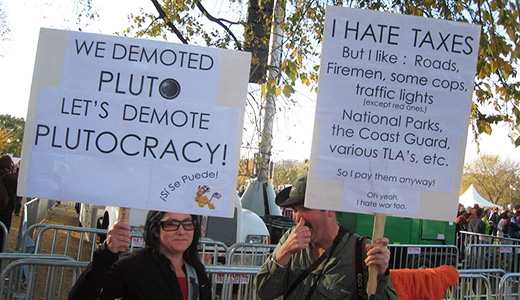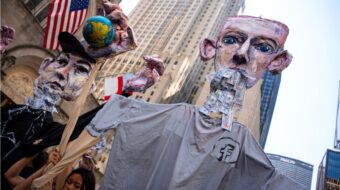
The rich, many Americans have come to believe, rule. But how? The current hubbub over the federal budget deficit opens a welcome window to understanding just how our rich keep riding so high.
How can you tell whether you live in a plutocracy? Easy. Just conduct this simple test. First, identify a “pressing problem” that pundits are splashing over your nation’s op-ed pages. Then take a glance at the “solutions” to this national woe that pop up, on these same op-ed pages, as “politically possible.”
If you live in a plutocracy, not one of these “politically possible” proposals will ever do more than, at worst, inconvenience your nation’s super rich.
Ready to put this plutocracy test to a real-life trial? Let’s consider the problem that America’s pundits have this fall tabbed as our nation’s most pressing: the federal budget deficit.
Earlier this month, the New York Times offered readers an interactive online opportunity to solve this deficit situation. Our national newspaper of record published a long list of deficit-cutting options, all culled from Washington insiders, and invited readers to choose enough of these options to end the deficit.
But readers who accepted this invitation to “fix the budget” quickly found themselves in a bit of an quandary. If these readers went through the Times list of insider suggestions and avoided all the options that would inflict pain on middle class families, they couldn’t get the deficit down to zero.
These same readers could, by contrast, hit that zero deficit target quite readily if they avoided any option that could inflict pain on America’s wealthy. In fact, the Times list had no options for inflicting significant sacrifice on people of wealth.
Some options on the list did, to be sure, call for higher taxes on high incomes. But these options, if ever adopted, would still leave the nation’s wealthy paying taxes at less than half the rate that the nation’s wealthy faced in the 1950s, under President Dwight Eisenhower, a Republican.
In Ike’s time, income over $400,000 – about $3.3 million today, after adjusting for inflation – faced a 91 percent tax rate. The strongest tax-the-rich options on the Times list – a return to the 39.6 percent top rate in effect during the Clinton years, coupled with a 5.4 percent surcharge on income over $1 million – would, if adopted, bring today’s top tax rate to only 45 percent.
That 45 percent essentially represents what America’s mainstream media consider the upper limit of the politically possible. We have, in other words, a society that defines as politically “impossible” a state of affairs – a 91 percent top marginal tax rate – that existed, for years, as a political reality.
A widely accepted political reality, we might add. Back in the mid 20th century, even celebrated conservative thinkers could and did support steep tax rates on high incomes. One example: University of Chicago economist Henry Simons, an influential free marketeer who consistently promoted progressive taxation.
Simons believed, as analysts Neil Brooks and Linda McQuaig have recently written, “that capitalism could only survive in a democracy if the general public benefited from it, and this involved redistributing its bounty, which otherwise ends up concentrated in the hands of the few.”
Many of America’s mid-20th-century wealthy did certainly disagree with Simons and whine incessantly about their heavy tax burden. But that tax burden had, over the years, trimmed the resources these wealthy could bring to bear. They simply did not enough dollars to bend U.S. politics overwhelmingly their way.
In 1955, as IRS records show, the nation’s 400 most affluent taxpayers averaged, in today’s dollars, just $12.8 million in income. To put that meager $12.8 million in perspective: In 2007, our top 400 averaged $344.8 million.
The rich of the mid 20th century had, of course, packs of politicians ready to do their bidding. But these politicos seldom dared to openly attack stiff progressive tax rates. By taking that step, these pols realized, they would almost certainly end up marginalizing themselves. Just like T. Coleman Andrews.
A close ally of Virginia’s top political boss, Andrews had become Eisenhower’s first Internal Revenue Service commissioner in 1953 and ran the IRS, by all accounts, in a workmanlike fashion. But Andrews resigned his IRS post in 1955 to take a job running an insurance company and then, a year later, suddenly and surprisingly emerged as an intense and shrill critic of the federal income tax.
High tax rates on high incomes, this “new” Andrews charged, amount to an “instrument of vengeance” that reflects a “dangerous trend toward socialism.”
“Maybe we ought to see that every person who gets a tax return,” Andrews told the US News & World Report in a May 1956 cover-story interview, “receives a copy of the Communist Manifesto with it.”
That interview endeared Andrews to the rich who saw red every April 15 – and essentially ended any hopes Andrews may have had for political success.
The November 1956 elections would see Andrews running for President on the fringe States’ Rights party ticket. From that debacle he would gravitate, by the early 1960s, to the John Birch Society – and total political irrelevance.
Throughout the years right after World War II, the savviest of the politicos who carried rich people’s water understood quite clearly that openly pushing for rich people-friendly changes to the tax code was never going to gain them much traction. These pols accepted, as a given, the public’s strong and solid support for progressive tax rates – and did their best to end run that public.
One end-run came in the 1940s, with a business drive to amend the Constitution and limit the top tax rate on high incomes to 25 percent. The strategists behind this effort recognized they had no shot at getting such a tax-cap amendment through Congress. They chose instead to take their case to state legislatures.
The states, notes University of California historian Isaac William Martin, offered business groups a “venue where public awareness of and participation in policy debates was limited.” To keep the public even more unaware, the groups launched their tax-cap blitz “in states far outside of national media markets.”
But public awareness did come eventually, and the tax-cap campaign, after scoring some initial backroom-deal successes, fizzled out by the late 1950s.
How distant those 1950s today seem. Our contemporary rich no longer feel the need to conspire in the shadows. They openly, at every turn, demand relief from taxes – and any other government action that might crimp their grand fortune-building capacity.
These rich don’t always get the exact relief they seek. They don’t yet have the power to win every battle they engage. But they do have the power to routinely define the issues and options that make their way onto the battlefield.
“The deficit, the Social Security shortfall, difficulties with Medicare,” the president of the United Steelworkers union, Leo Gerard, observed last week, “they could all be solved if the nation returned to taxing policies that existed under Republican President Gen. Dwight D. Eisenhower.”
At the moment, that return sits nowhere near our mainstream political radar screen. And even more modest tax-the-rich proposals, like the deficit-reduction package Rep. Jan Schakowsky from Illinois presented last Tuesday, go almost totally ignored. That’s not right. That’s plutocracy.
Sam Pizzigati edits Too Much, an online weekly on excess and inequality published by the Institute for Policy Studies. This article is reposted from OurFuture.org.
Photo: Grace C CC 2.0










